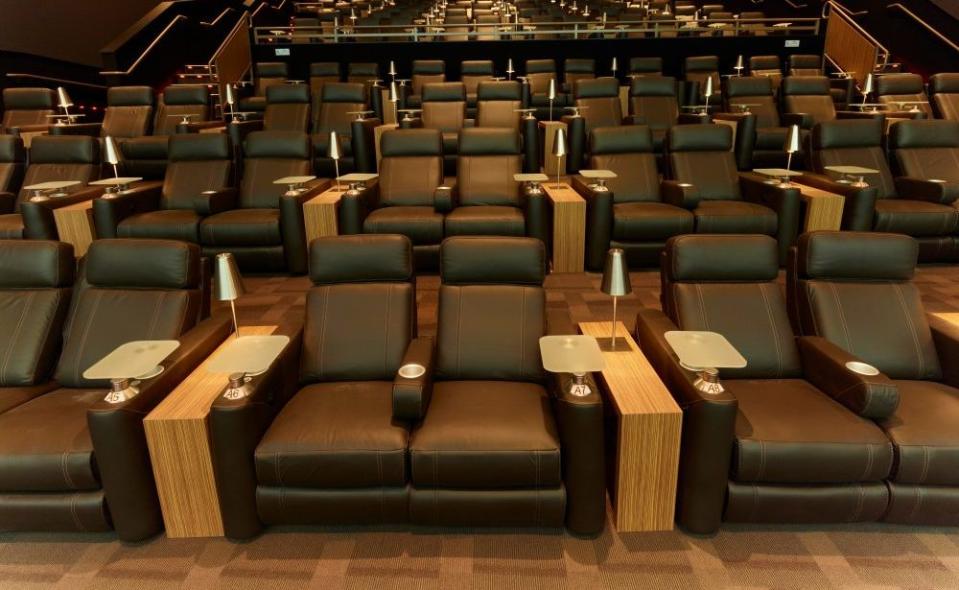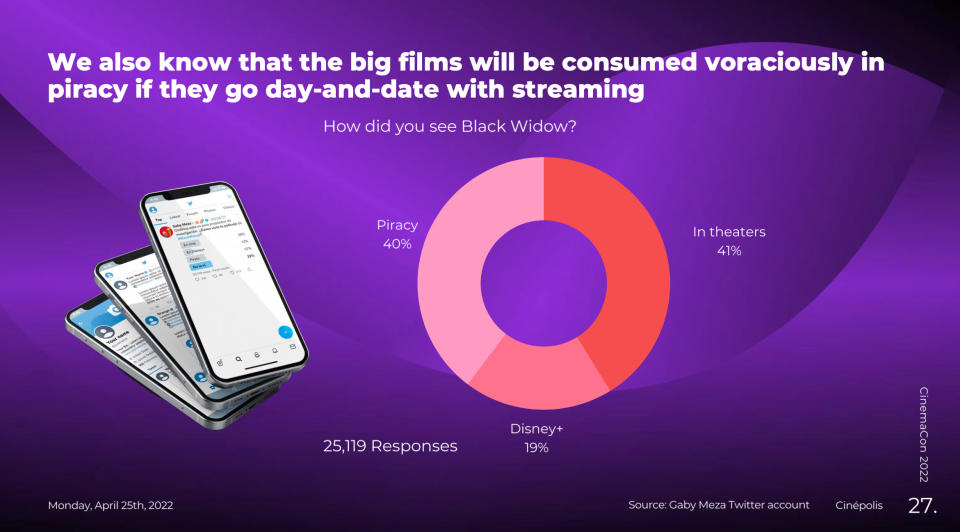The Only Exhibitor That Grew in the Pandemic Has Thoughts About What Theaters Must Do Next

After two years of periodic lockdowns and a box office that’s slow to recover, not all theater news was bad: The world’s third-largest theater chain, Mexico-based Cinepolis, emerged from the pandemic with more cinemas, growing from 624 theaters and 5,800 screens in 2019 to 800 theaters and 6,661 screens today.
Speaking to IndieWire during CinemaCon, Cinepolis CEO Alejandro Ramírez Magaña credits some of that success to diversification; playing the BTS Concert event “Permission to Dance” in his theaters, “We sold almost half a million tickets at five times the average price for a movie, most of which were sold in the first 72 hours for the film industry going forward,” he said. “It’s crazy.” The need for diversification extends to the films themselves, but that’s only one of many strategies that will be necessary for exhibitors to thrive.
More from IndieWire
Theaters Will Be Back with 'Doctor Strange,' but This Weekend Box Office Hits an All-Time April Low
'Top Gun: Maverick' and 'Avatar: The Way of Water': Can a Sequel Be Too Late?
1. Brand films in theaters.
Studios and streamers enhance a movie’s value, said Ramirez. While he recognizes that distributors will channel many titles straight to streaming, Ramirez wants studios to see “that they will perform better in their streaming platforms, if they first go through the cinemas,” he said. “With the streaming wars, people just can’t differentiate, there’s just so many platforms. And then once you enter one, there’s so much content that you don’t know what to watch, because nobody’s heard of any of these films.”
Ramirez believes that anonymity also contributes to the analysis paralysis many face when confronted with near-infinite choices of what to watch next. The less friction in making that choice, the better. “Part of the reason why people watch series the most is because once you like one, you don’t have to decide for the next several days or weeks until you finish,” he said. “But feature films that do not have a theatrical run first, go unnoticed a lot of the time.”
2. Convince studios to supply more movies.
Studios often responded to pandemic shutdowns by moving dates, and sometimes to other platforms. “We’re seeing that most of the studios are keeping their dates firm,” he said. “We’re seeing more commitment from the studios to not move dates. ‘Doctor Strange’ is coming on May 5, ‘Top Gun: Maverick,’ then ‘Jurassic World: Dominion,’ ‘Lightyear,’ ‘Minions: The Rise of Gru,’ and ‘Thor: Love and Thunder.’ It’s a robust summer lineup for the next nine weeks. That is the beginning of seeing the studios release content on a regular, uninterrupted basis. We want to have a more consistent flow of content, so that we don’t have the gaps and ups and downs that we experienced over the past two years.”
3. Don’t give up on older audiences.
Theaters are still wondering how long it will take for older moviegoers to return. “We’ve seen that different demographics return at different speeds,” said Ramirez. “Obviously the younger people always feel less vulnerable to COVID, but slowly we’re seeing that every age group is returning. There’s probably a segment that may not come back, but we think it’s gonna be rather small.”

Disney/Pixar
4. Book family films.
Play family movies and adults will come with their children in tow, as “Sonic the Hedgehog 2” recently proved with $288 million worldwide. While Disney diverted Pixar titles “Soul,” “Luca” and “Turning Red” to Disney+, the studio promises to stick with a June 17 theatrical opening for “Toy Story” spinoff “Lightyear.” There’s no reason not to.
“That’s going to be the first Pixar released [theatrically] since the pandemic began,” said Ramirez. “We believe it can be one of the top films of the year. In Mexico, the record for highest-grossing film of all time is ‘Spider Man: No Way Home.’ But the film with the highest admissions in history is ‘Toy Story 4,’ more than ‘Spider Man’ or ‘Avengers: Endgame,’ because in Latin America, and in particular, Mexico, family films do a lot of admissions (at a lower price because kids pay lower ticket prices). That’s why it’s number three in box office, but it’s number one in admissions.”
5. Create a diverse and consistent flow of titles — not just movies.
Cinepolis made a fortune with the BTS “Permission to Dance” concert event. Most of the premium-priced tickets were sold in the first 72 hours; 90 percent of their multiplexes were sold out. “Alternative content,” Ramirez said, “non-traditional content has been doing very well.”
What theaters really need, he said, is “movies of every size, not only the tentpoles. We also need those medium-sized and smaller films in different genres. We don’t only need the big action movies and the family films, but we also need comedies and romantic comedies. Horror has been doing well, but we also need dramas. We need to start feeding the marquee, we need to start programming films on a continuous basis for all different audiences.”
6. Book the streamers’ movies.
If movies from Netflix, Amazon, and AppleTV+ have a theatrical window, Cinepolis is happy to play them. “It is to the benefit of streaming platforms to release in theaters, not only because they can make significant money, but also because films will later do better in streaming,” he said. “Some studios are coming to the conclusion that a theatrical release helps them down the line in their own streaming platform. We started conversations over the pandemic also with other non-Hollywood studios and streamers like Netflix; they’re analyzing their options.”

Cinepolis
7. Offer a mix of screening environments.
Cinepolis was a premium-theater pioneer, opening its first VIP cinema in Mexico City in 1999, and Ramirez said it now boasts more premium cinemas than any other chain. However, that’s not enough. “There’s important demographics that are not looking necessarily for a premium and more expensive experience,” he said. “They just want to go to have a great time in a great movie theater with technology with big-size screens, great projection and sound, comfortable seats, a frictionless experience in which they can reserve through their app, acquire the tickets without any queues in any box office, and buy their food and beverages on the app.”
In Latin America, VIP experiences are less than 10 percent of all screens. Cinepolis focused on premium cinemas in higher-income countries like the U.S., where “all of our cinemas have recliner seats, and most of them have also waiter service to your seat and a wider variety of food and beverages, including a full bar,” said Ramirez. “The fastest recovery in many markets are the luxury cinemas and the premium cinemas. That’s where you have the most physical distance to other customers. So when people were a little bit anxious about going to enclosed spaces, you’re not rubbing elbows with anyone; there’s a side table that separates you, and much wider seats. Also, in many countries people who go to the premium experience were probably the first ones that had access to vaccines.”

Cinépolis
8. Fight piracy.
The best way to keep pristine copies off the internet is not to release them day and date, said Ramirez. Each week, Torrentfreak lists the 10 most-pirated films worldwide. Compare those films to ones with theatrical exclusives and you see that the longer the window, the longer it takes to make the top 10. “It’s lot of money,” he said. “For five weeks, your movie sells tickets rather than everybody downloading it for free.”
9. Play with dynamic pricing.
Steep discounts for daytime and weekday showings create value for Cinepolis customers. Like other international exhibitors, Cinepolis has tried dynamic pricing in Mexico, Colombia, and India, so that “depending on the seat type, within an auditorium, you can have different prices,” Ramirez said. “In theaters that only have one type of seat, we haven’t experimented with selling different prices in different parts of the cinema, because our cinemas offer stadium seating and we leave enough room from the screen to the first row so almost everybody has a good view. We already have enough dynamism in our price structure for customers with different price sensitivities. But we will continue to experiment.”
Best of IndieWire
Nightmare Film Shoots: 28 of the Most Grueling Films Ever Made
New Movies: Release Calendar for April 29, Plus Where to Watch the Latest Films
Sign up for Indiewire's Newsletter. For the latest news, follow us on Facebook, Twitter, and Instagram.

